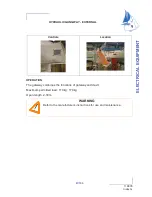
Helm Systems
2-3
Section 2
C238
2.6 Steering System
The steering system is hydraulic and made
of two main components: the helm assembly
and the hydraulic cylinder. The helm unit
acts as both a fluid reservoir and pump.
Turning of the helm, or steering wheel,
pumps the fluid in the hydraulic hoses and
activates the hydraulic cylinder causing the
motors to turn. A slight clicking sound may
be heard as the wheel is turned. This sound
is the opening and closing of valves in the
helm unit and is normal. Refer to the steer-
ing manufacturer owner’s manual for spe-
cific information on the steering system.
Tilt Helm
A tilt helm, steering wheel may be installed
on your boat. To tilt the helm, depress the
lever located in the base of the helm and
lock into position. DO NOT adjust when the
boat is underway.
2.7 Trim Tabs
The trim tabs are recessed into the hull on
the transom. Switches are used to control
the trim tabs. The switches are labeled to
indicate the reaction of the bow of the boat.
They control starboard and port up and
down movements. Bow up and bow down
will control the hull planning attitude, while
port and starboard up and down provide
control for the hull trim side to side.
Before leaving the dock, make sure that the
tabs are in the full “UP” position by holding
the control in the bow "UP" position for ten
seconds. Do not continue to operate the
switch when the tabs are fully up or down.
Establish the intended heading and cruise
speed before attempting to adjust the hull
attitude with the trim tabs. Always make
slight adjustments to reduce over adjust-
ments. After stabilizing speed and direction,
move the trim tabs to achieve a level side to
side running attitude being careful not to
over trim.
After depressing a trim tab switch, always
wait a few seconds for the change in the trim
plane to take effect.
Avoid depressing the switch while awaiting
the trim plane reaction. By the time the effect
is noticeable the trim tab plane will have
moved too far and the boat will be in an
overcompensated position.
When running at a speed that will result in
the boat falling off plane, lowering the tabs
slightly, bow down, will improve the running
angle and operating efficiency. Too much
bow down tabs can reduce operating effi-
ciency and cause difficult steering and han-
dling.
When running at high speeds, make sure
the tabs are in the full “UP” position. Only
enough trim plane action should be used to
compensate for any listing. Trim tabs are
more sensitive at higher speeds. Adjust for
this and be prepared to slow down if difficul-
ties arise.
Be extremely careful when operating in a fol-
lowing sea. The effect of trim tabs is ampli-
fied under these conditions. Difficulty in
steering and handling can result from
improper trim tab usage, especially in a fol-
lowing sea; raise the tabs to the full bow
"UP" position.
When running into a chop, a slight bow
down attitude will improve the ride. Be care-
ful not to over trim, difficulty in handling can
result.
Engine Stop Switch
Summary of Contents for C238
Page 1: ...October 2015 December 2015...
Page 2: ...NOTICE This manual may contain pictures or discussions of options not available on SE models...
Page 6: ......
Page 10: ...Operator Notes 8 C238...
Page 20: ...Operator Notes 2 6 C238...
Page 34: ...5 6 Operator Notes C238...
Page 36: ...6 2 Operator Notes C238...
Page 42: ...8 2 Operator Notes C238...
Page 50: ...Operator Notes 9 8 C238...
Page 74: ...12 6 Operator Notes C238...
Page 80: ...Operator Notes A 6 C238...
Page 82: ...Appendix B Maintenance Log Date Hours Dealer Service Repairs B 2 C238 Maintenance Log...
Page 83: ...Maintenance Log B 3 Appendix B C238 Date Hours Dealer Service Repairs...
Page 84: ...Appendix B Maintenance Log Date Hours Dealer Service Repairs B 4 C238...
Page 85: ...Boating Accident Report C 1 Appendix C C238 Boating Accident Report...
Page 86: ...C 2 Appendix C Boating Accident Report C238...
Page 87: ...Float Plan D 1 Appendix D C238 Float Plan...
Page 88: ...Operator Notes D 2 C238...
Page 92: ...Operator Notes E 4 C238...
Page 93: ...Schematics F 1 Appendix F C238 Schematics...
Page 94: ...F 2 Appendix F Schematics C238...
Page 95: ...Schematics F 3 Appendix F C238...
Page 96: ...F 4 Appendix F Schematics C238...
Page 97: ...Schematics F 5 Appendix F C238...
Page 98: ...F 6 Appendix F Schematics C238...
Page 99: ...Schematics F 7 Appendix F C238...
Page 100: ...F 8 Appendix F Schematics C238...
Page 101: ...Schematics F 9 Appendix F C238...
Page 102: ...F 10 Appendix F Schematics C238...
Page 103: ...Schematics F 11 Appendix F C238...
Page 104: ...F 12 Appendix F Schematics C238...
Page 105: ...Schematics F 13 Appendix F C238...
Page 106: ...F 14 Appendix F Schematics C238...
Page 107: ...Schematics F 15 Appendix F C238...
Page 108: ...F 16 Appendix F Schematics C238...
Page 109: ...Schematics F 17 Appendix F C238...
Page 110: ...F 18 Appendix F Schematics C238...
Page 111: ...Schematics F 19 Appendix F C238...
Page 112: ...F 20 Appendix F Schematics C238...
Page 113: ...Schematics F 21 Appendix F C238...
Page 114: ...F 22 Appendix F Schematics C238...
Page 115: ...Schematics F 23 Appendix F C238...
Page 116: ...Operator Notes F 24 C238...
Page 117: ......
Page 118: ......
















































